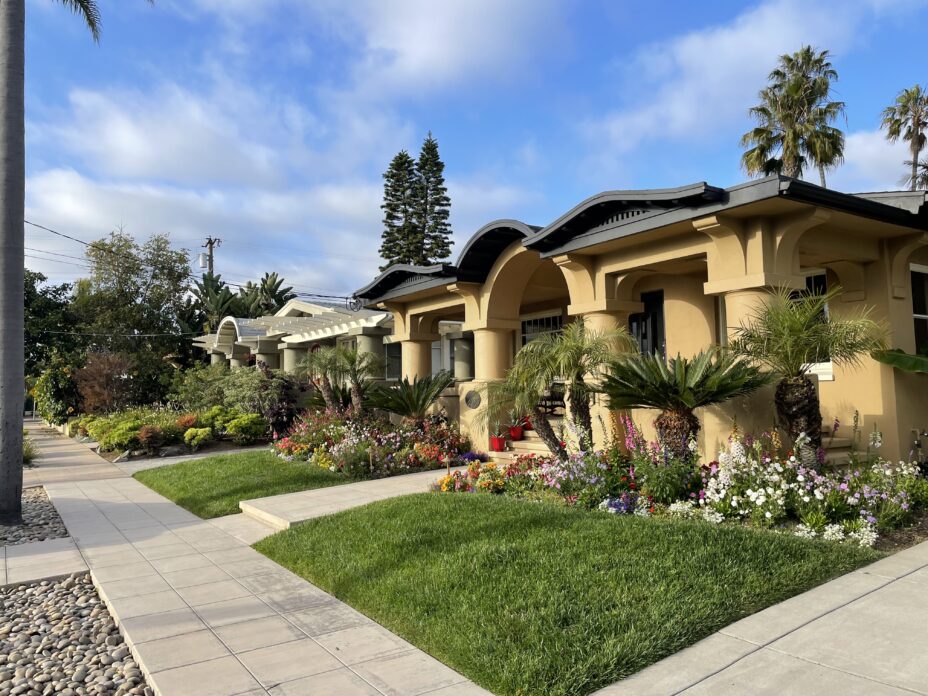Arnold & Choates Addition – North Florence Heights Historic District Placed on the National Register
On May 3, 2024, the California State Historical Resources Commission (SHRC) voted unanimously to recommend the Arnold & Choates Addition—North Florence Heights historic district for listing on the National Register of Historic Places. Since then, the Keeper of the National Register formally accepted the recommendation and on July 9, 2024, placed the district on the National Register. This action will help protect this remarkably intact enclave of early twentieth century architecture and San Diego history.

The vote was the culmination of a two-year effort led by Mission Hills Heritage (MHH) and community members to create an official historic district for this neighborhood. The district’s boundaries generally correspond with the historical boundaries of two contiguous subdivisions—the 1872 Arnold and Choate’s Addition and the 1890 North Florence Heights—and encompasses approximately 350 homes and buildings. (See map that accompanies this article.) MHH engaged the consulting firm of Architectural Resources Group (ARG) to assist with drafting the very detailed nomination report while MHH performed outreach to property owners and launched a publicity campaign to apprise the local community of the effort.
The report can be viewed at: www.missionhillsheritage.org/news/arnold-choates-north-florence-heights/
The beauty and elegance of early twentieth century architecture is on full display in the district. There is a wide range of architectural styles executed by numerous recognized master builders, including Martin Melhorn, Morris Irvin, Nathan Ridgon and others, yet the district is remarkably cohesive in aesthetic and visual character. And this area has remained remarkably intact, even as many of the surrounding areas have witnessed significant alterations due to redevelopment over the years. Landmarks buildings, such as the Rigdon Block and the Montclaire on West Lewis Street, neighborhood churches and Francis Parker School have changed little since their construction.
In addition to the fabulous architecture, this neighborhood is also a truly excellent representation of an early streetcar suburb and is one of the best examples of how the expansion of the electric streetcar service in the early twentieth century shaped development patterns in San Diego. The neighborhood catered to middle-income households, with mostly modest homes on smaller, compact lots, with some larger homes on the fringes. Small-scale commercial, mixed use and institutional buildings—including shops, churches and schools—were woven into the community, supporting the development of the neighborhood.
During the May 3rd hearing, SHRC staff confidently recommended that the SHRC approve the nomination as eligible for listing on the National Register. After that, Barry Hager of MHH and Andrew Goodrich of ARG made presentations in support of the nomination, both highlighting the integrity of and range of architectural styles within the district.
Although housing advocates from other areas of the state spoke in opposition to the nomination, the commissioners rejected the notion that housing issues and real estate forces are relevant to their decision under the applicable rules. Comparatively, Commissioners Janet Hansen, Lee Adams III, and Alan Hess readily recognized the significance of the district as a streetcar suburb and Commissioner Luis Hoyos noted that the nomination was “very carefully written, and very carefully researched.”
It should be noted that historic districts are not incompatible with new housing. ADUs and Junior ADUs can still be built on properties within such a historic district, regardless of whether the properties are contributors or non-contributors. Additions to existing homes and buildings are also allowed within guidelines.
As stated by the State Historic Preservation Officer in a recent letter to district residents announcing the listing, no restrictions are placed upon the property owner regarding “normal use, maintenance, or sale of a property listed in the National Register.” “However, a project that may cause substantial adverse changes in the significance of a registered property may require compliance with local ordinances or the California Environmental Quality Act.” With placement on the National Register secured, in the words of Commissioner Hoyos at the May 3rd hearing, the new historic district “will continue to delight [future generations.]”
MHH wishes to thank the community for its support of this new historic district—over 50 letters of support were received by the SHRC prior to the hearing. The new district will help preserve the rich architectural history and sense of place that embodies the Mission Hills neighborhood and has drawn generations of residents to the area. We look forward to this newest addition to the historic districts in our community. You can support our important work by donating to Mission Hills Heritage on our website at: www.missionhillsheritage.org.
Category: Architecture, Culture, Historical, Housing, Life Style, Local News, Nonprofit







